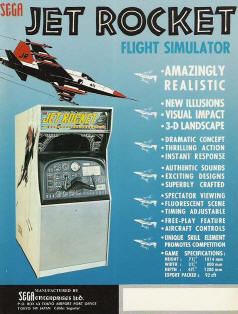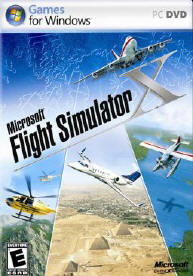Flight Simulation
 HISTORY:
Prior to the rise of video games, Sega produced arcade games that resemble video
games, but were in fact electro-mechanical games that used rear image projection
in a manner similar to the ancient zoetrope to produce moving animations on a
screen. One such electro-mechanical game by Sega was Jet Rocket, a crude flight
simulator featuring cockpit controls that could move the player aircraft around
a landscape displayed on a screen and shoot missiles onto targets that explode
when hit. In 1975, Taito released a simulator video game, Interceptor, which was
a crude arcade first-person combat flight simulator that involved using an
eight-way joystick to aim with a crosshair and shoot at enemy aircraft that move
in formations of two and scale in size depending on their distance to the
player. HISTORY:
Prior to the rise of video games, Sega produced arcade games that resemble video
games, but were in fact electro-mechanical games that used rear image projection
in a manner similar to the ancient zoetrope to produce moving animations on a
screen. One such electro-mechanical game by Sega was Jet Rocket, a crude flight
simulator featuring cockpit controls that could move the player aircraft around
a landscape displayed on a screen and shoot missiles onto targets that explode
when hit. In 1975, Taito released a simulator video game, Interceptor, which was
a crude arcade first-person combat flight simulator that involved using an
eight-way joystick to aim with a crosshair and shoot at enemy aircraft that move
in formations of two and scale in size depending on their distance to the
player.
Crude flight simulators were among the first types of programs to be developed
for early personal computers. Bruce Artwick's subLOGIC simulators were
well-known for the functionality they managed to get onto 8-bit machines. Key
computer game technologies such as 3D graphics, online play, and modding were
first showcased in combat flight simulators such as Red Baron II and European
Air War. The game world in flight simulators is often based on the real world.
However, they are often confined to one part of the game world by invisible
boundaries. In some games, the aircraft simply halts in midair, while other
games force the player to turn around. However, many games solve this boundary
problem by wrapping the game world as a sphere.
Although these games strive for a great deal of realism, they often simplify or
abstract certain elements to reach a wider audience. Many modern fighter
aircraft have hundreds of controls, and flight simulator games usually simplify
these controls drastically. Further, certain maneuvers can knock a pilot
unconscious or rip their aircraft apart, but games do not always implement these
concerns.
A popular type of flight simulator are combat flight simulators, which simulate
combat air operations from the pilot and crew's point of view. Combat flight
simulation titles are more numerous than civilian flight simulators due to
variety of subject matter available and market demand.
In the early 2000s, even home entertainment flight simulators had become so
realistic that after the events of September 11, 2001, some journalists and
experts speculated that the hijackers might have gained enough knowledge to
steer a passenger airliner from packages such as Microsoft Flight Simulator.
Microsoft, while rebutting such criticisms, delayed the release of the 2002
version of its hallmark simulator to delete the World Trade Center from its New
York scenery and even supplied a patch to delete the towers retroactively from
earlier versions of the sim.
The advent of flight simulators as home video game
entertainment has prompted many users to become "airplane designers" for these
systems. As such, they may create both military or commercial airline airplanes,
and they may even use names of real life airlines, as long as they don't make
profits out of their designs. Many other home flight simulator users create
fictional airlines, or virtual versions of real-world airlines, so called
virtual airlines. These modifications to a simulation generally add to the
simulation's realism and often grant a significantly expanded playing
experience, with new situations and content. In some cases, a simulation is
taken much further in regards to its features than was envisioned or intended by
its original developers. Falcon 4.0 is an example of such modification; "modders"
have created whole new warzones, along with the ability to fly hundreds of
different aircraft, as opposed to the single original flyable airframe.
 One
way that users of flight simulation software engage is through the internet.
Virtual pilots and virtual air traffic controllers take part in an online flying
experience which attempts to simulate real-world aviation to a high degree.
There are several networks where this sort of play is possible, the most popular
ones being VATSIM and IVAO. Virtual Skies provides a low barrier of entry
allowing any level member to fly or control without worrying if something goes
wrong. Virtual Skies covers mainly UK & USA VATSIM and is generally regarded to
have better coverage of the virtual North America and Great Britain, while
IVAO's pilots and controllers generally fly and control the virtual Europe,
Africa and South America. IVAO's ATC certification process is not as strict as
VATSIM's, which allows for a greater number of controllers to be available, but
guarantees their proficiency to a lesser degree than VATSIM. Both networks
receive anywhere from 300 to 900 ATC and pilot connections, depending on the
time of day. One
way that users of flight simulation software engage is through the internet.
Virtual pilots and virtual air traffic controllers take part in an online flying
experience which attempts to simulate real-world aviation to a high degree.
There are several networks where this sort of play is possible, the most popular
ones being VATSIM and IVAO. Virtual Skies provides a low barrier of entry
allowing any level member to fly or control without worrying if something goes
wrong. Virtual Skies covers mainly UK & USA VATSIM and is generally regarded to
have better coverage of the virtual North America and Great Britain, while
IVAO's pilots and controllers generally fly and control the virtual Europe,
Africa and South America. IVAO's ATC certification process is not as strict as
VATSIM's, which allows for a greater number of controllers to be available, but
guarantees their proficiency to a lesser degree than VATSIM. Both networks
receive anywhere from 300 to 900 ATC and pilot connections, depending on the
time of day.
Much rarer but still notable are flight simulators available for various game
consoles. One of the most notable of these were Pilotwings, made available for
the Super Nintendo, the sequel Pilotwings 64 for the Nintendo 64 and the Ace
Combat series on PlayStation 1&2. The very rare Sky Odyssey is yet another
example of console flight simulators. Due to the restrictive nature of a game
console's ability to simulate environments properly in general and the
processing limitations of these systems in particular, game console-based flight
simulators tend to be simplistic and have a more arcade-like feel to them. While
generally not as complex as PC based simulators, console flight simulators can
still be enjoyable to play, though their 'simulation' status is disputed by many
in the flight simulation community. *
* Source: Wikipedia
|
|
More useful information and tools will be
coming soon to this page!
*****
We are looking for contributors to share
hints, trivia, and other flight and space sim software information that may
interest our visitors.

|


